Dahlia flower are renowned for their vibrant blooms, diverse forms, and extensive color palette. Originating from the mountainous regions of Mexico and Central America, these plants belong to the Asteraceae family, which includes sunflowers and daisies. With over 42 species and thousands of cultivars, dahlias offer an incredible array of flower shapes, sizes, and colors, making them prized additions to gardens, borders, and floral arrangements.
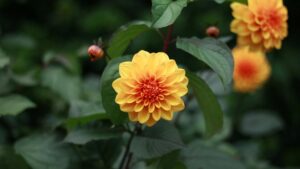
Dahlias are characterized by their showy, symmetrical flowers, which can range from simple single blooms to intricate double or cactus varieties with numerous petals. The flowers come in an assortment of hues, including vibrant reds, oranges, yellows, pinks, purples, and whites, as well as bi-color and multi-color combinations. Their foliage is typically dark green and lush, providing an attractive backdrop to the colorful blooms.
These versatile plants thrive in various climates and soil conditions, although they prefer full sun and well-drained, fertile soil. Dahlias are commonly grown from tubers, which resemble small potatoes, and can be planted in spring after the last frost has passed. With proper care, including regular watering, feeding, and deadheading spent blooms, dahlias can produce an abundance of flowers from midsummer to the first frost.
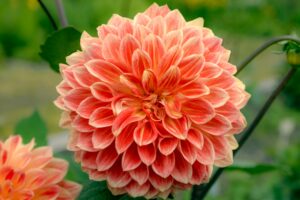
Whether grown in gardens, containers, or cut flower beds, dahlias are cherished for their ability to bring beauty and vibrancy to any setting. From formal garden displays to informal cottage gardens, these enchanting flowers continue to captivate gardeners and flower enthusiasts worldwide with their stunning colors and captivating forms.
Cultivars of Dahlia Flowers
Dahlias boast an extensive array of cultivars, each offering unique flower forms, colors, and sizes to suit various tastes and garden styles. Some popular cultivars include:
‘Bishop of Llandaff’: This variety is renowned for its striking deep red, almost burgundy, blooms and dark foliage, making it a standout in the garden.
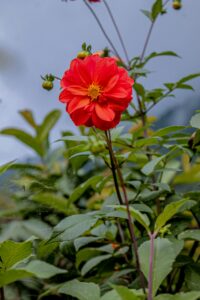
‘Cafe au Lait’: A favorite among floral designers, ‘Cafe au Lait’ produces large, creamy blooms with hints of blush pink and peach, adding elegance to bouquets and garden beds.
‘Karma Choc’: This dahlia features rich, velvety dark chocolate-colored blooms that stand out in borders and floral arrangements.
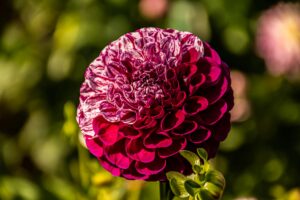
‘Thomas Edison’: Named after the famed inventor, ‘Thomas Edison’ showcases deep purple, almost black, blooms that add drama and sophistication to any garden.
‘Ferncliff Illusion’: Known for its mesmerizing bi-color blooms, ‘Ferncliff Illusion’ produces flowers with a blend of soft orange and pink hues, creating a captivating display.

‘Cactus Star’: With its spiky, fully double blooms, ‘Cactus Star’ adds a unique texture to garden beds and floral designs, featuring vibrant shades of yellow, orange, and red.
‘Gallery Pablo’: This compact variety is perfect for containers and small spaces, producing an abundance of vibrant, daisy-like blooms in various colors.
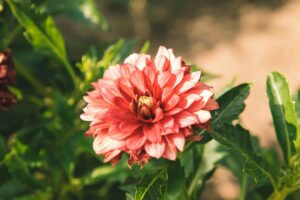
‘Dinnerplate’ series: As the name suggests, these dahlias produce enormous, dinner plate-sized blooms in an array of colors, including pink, purple, red, and white, making them a focal point in any garden.
These are just a few examples of the vast selection of dahlia cultivars available, each offering its own beauty and charm to enhance gardens, borders, and floral arrangements.
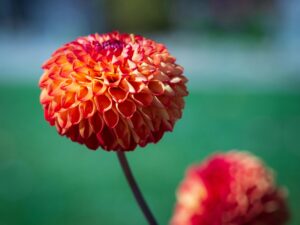
Sunlight Requirement of Dahlia Flower
Dahlias generally prefer full sun to thrive and produce abundant blooms. They require at least 6 to 8 hours of direct sunlight per day to grow vigorously and develop their vibrant flowers. In areas with hot summers, providing some afternoon shade can help protect the plants from intense heat and prolong the blooming period.
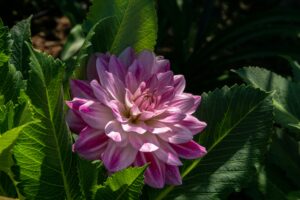
Temperature and Humidity Requirement of Dahlia Flower
Dahlias thrive in moderate temperatures, generally preferring daytime temperatures between 60°F to 70°F (15°C to 21°C). They can tolerate slightly higher temperatures but may require additional watering and protection from intense afternoon sun during hot weather to prevent wilting and sunburn. Nighttime temperatures around 50°F to 60°F (10°C to 15°C) are ideal for dahlias.
As for humidity, dahlias prefer moderate to low humidity levels. If growing dahlias in areas with high humidity, selecting disease-resistant varieties and providing proper spacing between plants can further help mitigate issues related to excessive moisture.
Soil Requirement of Dahlia Flower
Dahlias prefer well-draining soil with good fertility. A loamy soil with a slightly acidic to neutral pH level around 6.5 is ideal for dahlia cultivation. The soil should be rich in organic matter to provide essential nutrients and promote healthy root development.
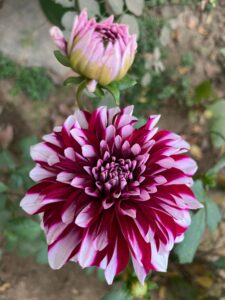
Dahlia Flower Propagation
Dahlia flowers can be propagated through various methods, including division, and cuttings.
Division: This is the most common method of propagating dahlias. It involves dividing the tuberous roots of established dahlia plants into smaller sections, each containing an eye or growing point. Here’s how to do it:
Wait until early spring or late autumn, when the plants are dormant.
Carefully dig up the dahlia tubers, taking care not to damage them.
Use a sharp, clean knife to divide the tubers into sections, ensuring that each section has at least one eye and some healthy roots attached.
Plant the divisions in well-prepared soil, spacing them according to the specific requirements of the dahlia variety.
Cuttings: Propagating dahlias from cuttings allows you to create new plants that are genetically identical to the parent plant. Here’s how to take cuttings:
Select a healthy, non-flowering stem from the parent plant.
Using a sharp knife or scissors, take a cutting that is around 4-6 inches long, making the cut just below a leaf node.
Remove any lower leaves from the cutting, leaving only a few leaves at the top.
Dip the cut end of the cutting in rooting hormone to encourage root growth.
Plant the cutting in a small pot filled with well-draining potting mix.
Keep the cutting in a warm, bright location and water it regularly until roots develop.
Once roots have formed, transplant the cutting into the garden or a larger container.
Propagation methods can vary depending on the specific requirements of the dahlia variety and your preferences as a gardener. Each method has its advantages and challenges, so choose the one that best suits your needs.
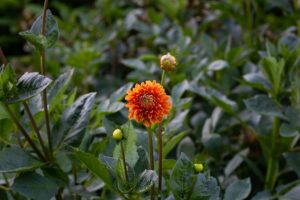
Potting Dahlia Tubers
Choose a container with drainage holes at the bottom to prevent waterlogging. Opt for a pot that is at least 12-18 inches deep and wide enough to accommodate the dahlia tuber comfortably.
Use a well-draining potting mix with a combination of garden soil, compost, and perlite or sand to provide good drainage and aeration. Avoid heavy soils that may retain too much moisture.
Position the dahlia tuber in the center of the pot with the growing point facing upwards. Cover the tuber with 2-3 inches of potting mix, leaving the top portion exposed.
Water the newly potted dahlia thoroughly to settle the soil around the tuber. Ensure the soil is evenly moist but not waterlogged. Place the pot in a location with bright, indirect sunlight.
Keep the soil consistently moist but not soggy during the growing season. Fertilize the dahlia plants regularly with a balanced fertilizer to support healthy growth and flowering.
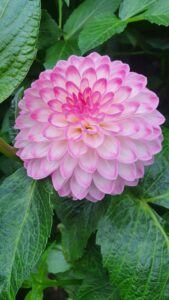
Water Requirements of Dahlia Flower
Dahlia flowers have moderate water requirements, but they are sensitive to both overwatering and under-watering. Water dahlia plants deeply and thoroughly whenever the top inch of the soil feels dry to the touch. During hot and dry weather, this may mean watering every 2-3 days, while in cooler or rainy conditions, less frequent watering may be necessary.
If growing dahlias in containers, check the moisture level of the potting mix regularly, as containers tend to dry out more quickly than garden beds. Water thoroughly until water drains from the bottom of the container, ensuring that the entire root ball is moistened.
Fertilizer Requirement of Dahlia Flowers
Apply fertilizer to dahlia plants when planting them in the spring and throughout the growing season to promote vigorous growth and flowering. Start fertilizing when new growth appears in spring and continue every 4-6 weeks until early fall. Use a balanced, water-soluble fertilizer with a formulation such as 10-10-10 or 20-20-20 to provide essential nutrients evenly to the plants. Alternatively, you can use a slow-release granular fertilizer applied to the soil at planting time or incorporated into the soil surface during the growing season.
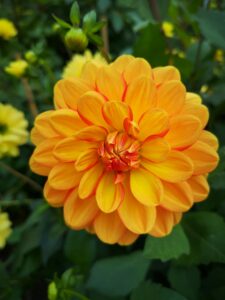
Stalking of Dahlia Flowers
Staking dahlia flowers is an important practice to support their tall stems and prevent them from bending or breaking, especially when they are laden with heavy blooms.
Select stakes that are sturdy enough to support the weight of the dahlia stems and blooms. Bamboo or wooden stakes are commonly used and should be at least 1-2 feet taller than the expected height of the dahlia plant.
Place the stakes around the perimeter of the dahlia plant, evenly spaced to provide adequate support. Position the stakes outside the outermost stems to avoid damaging the tubers.
Carefully insert the stakes into the soil next to the dahlia plant, ensuring they penetrate the ground deeply for stability. Aim to place the stakes close to the base of the stems without causing damage to the roots.
As the dahlia stems grow, gently tie them to the stakes using soft garden twine or stretchable plant ties. Avoid using materials that may cut into the stems or restrict their growth. Tie the stems loosely to allow for natural movement and expansion.
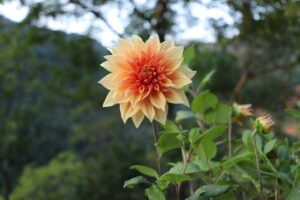
Regularly check the dahlia plants as they grow to ensure the stems are adequately supported and tied to the stakes. Adjust the ties as necessary to prevent constriction or damage to the stems.
For larger or heavier dahlia varieties, consider using multiple stakes or a trellis system to provide additional support. This is especially important for tall or bushy varieties that may produce numerous blooms.
Throughout the growing season, continue to monitor the dahlia plants and their stakes, especially after heavy rainfall or strong winds. Reinforce or adjust the stakes as needed to maintain optimal support.
By staking dahlia flowers properly, you can help prevent stem breakage, promote upright growth, and showcase the beautiful blooms to their full potential.
Problems while Growing Dahlia Flowers
Several challenges may arise when growing dahlia flowers, including:
Pest Infestations: Common pests such as aphids, spider mites, and earwigs can damage dahlia foliage and flowers. Regular inspection and appropriate pest management strategies like insecticidal soap or neem oil can help control infestations.
Disease Susceptibility: Dahlia plants are susceptible to various diseases such as powdery mildew, gray mold (Botrytis), and bacterial wilt. Providing good air circulation, avoiding overhead watering, and practicing proper sanitation measures can help prevent disease outbreaks.
Root Rot: Overwatering or poorly draining soil can lead to root rot in dahlia plants. Ensure proper soil drainage and avoid waterlogging to prevent this fungal disease. Planting dahlias in raised beds or containers with well-draining soil can also mitigate the risk.
Stem Breakage: Tall dahlia varieties may require staking to support their stems and prevent breakage, especially during windy conditions or heavy rain. Properly staking the plants and tying them securely can minimize this issue.
Tuber Rot: Improper storage or planting of dahlia tubers can result in tuber rot, especially in wet or poorly ventilated conditions. Store tubers in a cool, dry place over winter and inspect them for signs of decay before planting.
Inadequate Flowering: Factors such as insufficient sunlight, overcrowding, or improper fertilization can lead to reduced flowering in dahlia plants. Ensure they receive adequate sunlight, proper spacing, and regular fertilization with a balanced fertilizer to promote robust growth and abundant blooms.
Weather Damage: Extreme weather conditions, such as heat waves, frosts, or heavy rainfall, can damage dahlia flowers and foliage. Protecting adverse weather events, such as using row covers or temporary shelters, can help mitigate damage.
Addressing these challenges through proper cultural practices, vigilant monitoring, and timely intervention can help ensure healthy growth and abundant blooms in dahlia plants.
Harvesting of Dahlia Flower for Cut Flowers
Harvesting dahlia flowers is an essential step to ensure their longevity and continued blooming. Here are some guidelines for harvesting dahlia flowers:
Wait until dahlia flowers are fully open and have reached their peak bloom before harvesting. The petals should be firm and fully colored, with no signs of wilting or damage.
Use sharp, clean garden shears or scissors to harvest dahlia flowers. Dirty or dull tools can introduce bacteria and pathogens, potentially shortening the vase life of the flowers.
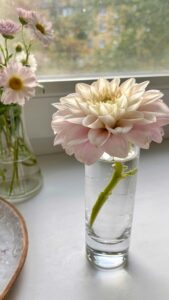
When harvesting, cut the stem of the dahlia flower at an angle, about 1-2 inches (2.5-5 cm) below the flower head. Cutting at an angle increases the surface area for water absorption and prevents the stem from sitting flat at the bottom of the vase.
For floral arrangements or bouquets, cut longer stems to the desired length. Leave enough stem length for arranging and supporting the vase.
Avoid removing all foliage from the dahlia plant when harvesting flowers. Leave some leaves on the plant to continue photosynthesis and support future flower production.
Continuously harvest dahlia flowers throughout the growing season to encourage more blooms. Regular harvesting prevents the plant from forming seed heads, redirecting energy into producing more flowers.
Handle harvested dahlia flowers gently to avoid damaging the petals or stems. Place them in a clean bucket or container filled with lukewarm water immediately after cutting to prevent wilting.
Before arranging the dahlia flowers in a vase, remove any foliage that will be below the waterline. Submerged foliage can decay and promote bacterial growth, shortening the vase life of the flowers.
By following these harvesting guidelines, you can ensure that your dahlia flowers remain fresh, vibrant, and long-lasting in arrangements or bouquets.
Ornamental Uses of Dahlia Flowers
Dahlia flowers are prized for their vibrant colors, diverse shapes, and lush blooms, making them popular choices for various ornamental purposes.
Garden Borders and Beds: Dahlia flowers are often used to create stunning garden borders and beds due to their large, colorful blooms and bushy foliage. They add vibrant splashes of color and visual interest to flower beds, enhancing the overall aesthetics of the garden.
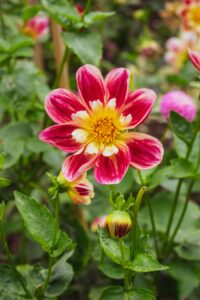
Cut Flower Arrangements: Dahlia flowers make exquisite additions to cut flower arrangements and bouquets. Their long stems and bold blooms add elegance and charm to floral displays, whether used alone or combined with other flowers and foliage.
Container Gardening: Compact or dwarf varieties of dahlia flowers are well-suited for container gardening. Planted in pots, hanging baskets, or window boxes, they provide bursts of color and beauty to balconies, patios, and outdoor living spaces.
Accent Plants: Dahlia flowers serve as striking accent plants in garden landscapes and outdoor settings. Placed strategically among shrubs, perennials, or ornamental grasses, they create focal points and draw attention with their dazzling blooms.
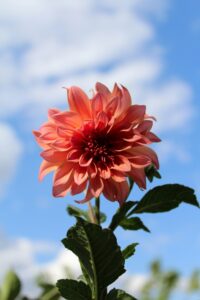
Border Edging: Dwarf or low-growing varieties of dahlia flowers are often used for border edging along pathways, flower beds, or garden borders.
Mass Plantings: Mass plantings of dahlia flowers can create breathtaking displays of color and texture in larger garden areas or public landscapes. Planting multiple varieties together in coordinated color schemes can result in stunning visual impact.
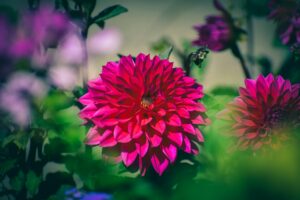
Indoor Decoration: Cut dahlia flowers are commonly used for indoor decoration, adorning dining tables, mantels, and other living spaces. Their vibrant colors and intricate petal shapes bring warmth and elegance to interior décor arrangements.
Overall, dahlia flowers offer endless possibilities for ornamental use, whether in outdoor garden landscapes, floral designs, or indoor décor, adding beauty, color, and charm wherever they are planted or displayed.


